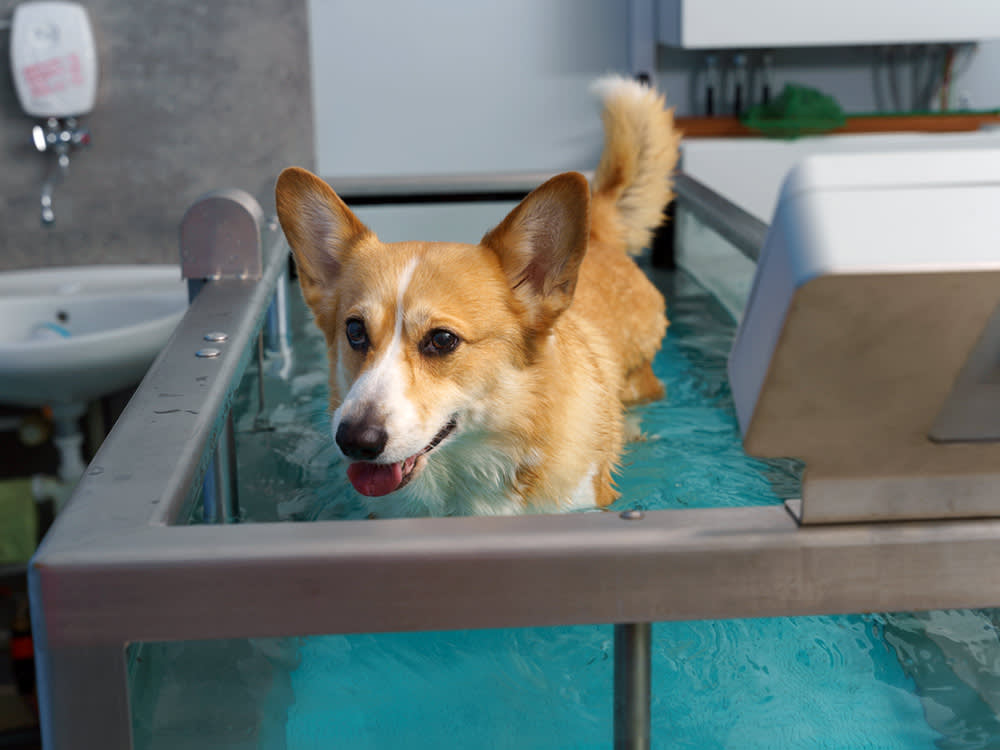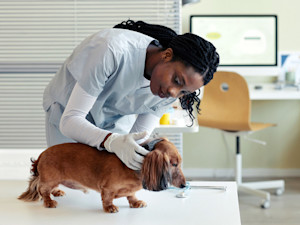What is Hydrotherapy For Pets?
Discover everything you need to know about this in-water treatment

Share Article
A few weeks ago, radio DJ Greg Jamesopens in a new tab shared an adorable video of his Labrador Barneyopens in a new tab working hard in a hydrotherapy pool, complete with stylish doggles (the dog version of goggles). If you’ve ever wondered why dogs and cats might need hydrotherapy, the health benefits and how it all works, then look no further. Below, registered veterinary nurse Samantha Bell explains all things animal hydrotherapy.
What is hydrotherapy
Hydrotherapy is a form of exerciseopens in a new tab that is often used in addition to physiotherapy as part of a rehabilitation plan to help pets recover from injury; and it also helps keep canine athletes fit for competition. It may surprise you that even cats can have hydrotherapy, too!

littleKin™ is Kinship’s home just for puppy and kitten parents. Bop over to check out expert advice, new pet tools, and special deals—all curated for your newest family member.
opens in a new tabHydrotherapy can only be started once wounds or surgical incisions have healed and should be performed by a suitably qualified person, which could be a veterinary physiotherapist or someone solely trained in hydrotherapy. In the UK, there are registers for qualified hydrotherapists including the National Association of Registered Canine Hydrotherapistsopens in a new tab and the Canine Hydrotherapy Associationopens in a new tab.
There is much more to hydrotherapy than just having a swimopens in a new tab, in fact swimming can be detrimental to certain dogs depending on their condition and this risk becomes greater if they’re swimming unaided. There are certain conditions that, if a pup has, means they should not swim at all due to the biomechanics of swimming. These include any type of compressive spinal cord injury and orthopaedic surgery such as a tibial plateau levelling osteotomy (TPLO) for cruciate ligament rupture.
Certain other prior medical conditions could mean hydrotherapy is not suitable for your pet, too, so the therapist will always need a veterinary referral and a complete clinical history prior to treatment. Such conditions include any serious cardiovascular or respiratory conditions, infectious skin diseaseopens in a new tab or certain gastrointestinal diseases.
Believe it or not, not every dog is a natural swimmer and this is why it is recommended to seek out the help of a qualified professional, especially if your dog is recovering from injury.
What conditions is hydrotherapy used to treat?
Conditions that benefit from hydrotherapy are categorised as follows:
orthopaedic
neurological
soft tissue injuries
conditions relating to age (developmental conditions in the young and degenerative conditions in the older animal)
degenerative and medical conditions
And more specifically, these conditions include:
cruciate ligament rupture – post operative or conservative management
hip dysplasia
elbow dysplasia
luxating patella (a dislocated knee cap)
degenerative myelopathyopens in a new tab (a disease that affects the spinal cord)
spinal injuries, including IV disc ruptureopens in a new tab and fractures
spondylosis (the degeneration of the bones and discs in the neck)
age-related mobility
What happens at a hydrotherapy session?
The water is set at a warm temperature (30–34C), which makes it comfortable for the patient and there will be bromine or chlorine added to the water to keep it safe and clean.
Hydrotherapy has two main modalities, pool (swimming) and the underwater treadmill. Whilst swimming in a pool can be used for rehabilitation, it is perhaps most suited to canine athletes as part of their fitness regime.
All patients should have a qualified therapist in with them when swimming but older or weaker patients should be guided through the water and may need the assistance of a buoyancy jacket before they become strong enough to swim by themselves.
After the hydrotherapy session your pet will be rinsed off in a shower before drying off to make sure the chemicals have been washed away (they may also get rinsed before the session as well). As hydrotherapy is a real workout, you should try to rest your pet for the rest of the day and be aware they may be sore for 24–48 hours afterwards (just like how you would be sore if you tried going to the gym for the first time in a long time).
To get the most benefit from hydrotherapy, it needs to be performed regularly, ideally once or twice a week initially and then gradually reducing to every other week and eventually to a maintenance session once every four to six weeks. However, this will depend on the condition and how your pet responds to the therapy. Most rehabilitation plans should also include exercises and treatments prescribed by a veterinary physiotherapist that are carried out daily at home in order for your pet to make a complete recovery.
What is underwater treadmill hydrotherapy?
Underwater treadmill hydrotherapy is the most common modality for rehabilitation for most orthopaedic and neurological conditions as part of a comprehensive physiotherapy programme but could be used for fitness work in some instances, too.
The underwater treadmill is so called because it is a treadmill belt that is within a glass and metal tank, which can be slowly filled with water to the desired height, this can be increased or decreased depending on what benefits the therapist is trying to achieve. The speed of the treadmill belt and even the incline of the belt can be adjusted, allowing for further individualised treatment options. Even if your dog is the type to walk around puddles, the vast majority of dogs actually get along really well with hydrotherapy, particularly the treadmill.
The therapist will make sure your pet is comfortable and happy walking on the treadmill before introducing water slowly. Each session will consist of sets of walking interspersed with rest periods to not overwork your pet. This means the first session could only include around two to three minutes of actual walking, which is broken up into several sets of around 30 seconds to one minute with breaks in between. During the breaks the therapist may perform massage or weight shifting, or may make adjustments to the water height or speed. Many therapists use mirrors to be able to see exactly how your pet is moving as they are often in the tank with them to help promote better movement patterns.
What are the benefits of hydrotherapy for pets?
A lot of the benefits of hydrotherapy are due to the properties of water. Some of the benefits include:
Improving joint range of motion: due to the buoyancy of water and the resistance when we or our pets walk through water, they have to bend and stretch their limbs more than they do when walking on land. This is good for improving the range their jointsopens in a new tab can move.
Improving strength and fitness: the resistance provided by the viscosity of water means a dog has to work harder to walk than they do on dry land, the shallower the water the harder it is! The speed of the treadmill can be adjusted to influence the length of their walking stride.
Balance: animals that have had a neurological disease may need help learning to walk again, the weightlessness of the water and the movement of the treadmill means that the therapist can help the patient work out where their legs need to go in a slow and controlled way. The hydrotherapist can also use devices like buoyancy jackets and slings to help support the patient initially and adjust the depth of water to support them.
Pain reliefopens in a new tab: the warmth of the water can reduce muscle tension and the hydrostatic pressure of the water can help reduce swelling. Additionally, the buoyancy of the water means they are not putting so much weight through a sore limb, which allows them to move with less pain and means they can build up fitness and strength without it hurting.
Hydrotherapy can be a lot of fun for our pets and also be fun for us to watch, even pets that don’t traditionally like water often learn to love having the hydrotherapy as they feel the benefits as well as probably enjoying all the snacks the therapist uses for motivation during the sessions!

Samantha Bell BSc Cert VNECC RVN
Samantha is a registered veterinary nurse, specialising in emergency and critical care. She is passionate about neurology, working as the specialist neurology nurse at Queens Veterinary School Hospital in Cambridge. Outside of work, Samantha dotes on her pony Maggie and her Romanian rescue dog Eadee. Spending her time outside of the hospital, she enjoys the outdoors with Maggie and snuggles on the sofa with Eadee.
Related articles
![A senior white dog with arthritis wearing a red collar standing by a large tree in the grass outside]() opens in a new tab
opens in a new tabPain Management for Canine Arthritis
Hope for dogs with arthritis is on the horizon
![]() opens in a new tab
opens in a new tabWhat to Do If Your Dog Has a Slipped Disc
A veterinary neurologist explains all
![Puppy lies in owner's lap and gets a belly rub]() opens in a new tab
opens in a new tabDIY Physical Exam Part 1 – How to Check Your Dog’s Vital Signs
Veterinarian Dr Shea Cox on how to take your dog’s temperature, find their pulse and check their heart rate
![Older dog playing with ball in a green field]() opens in a new tab
opens in a new tabDog Arthritis Treatment: How to Relieve Arthritis Pain in Dogs
Tips for treating achy joints – from medications to massages
![Two brown senior pointer dogs]() opens in a new tab
opens in a new tab‘Old Dog’ Vestibular Disease and Treatment
If you have an older dog, they could have a condition called idiopathic vestibular disease. Here’s everything you need to know







